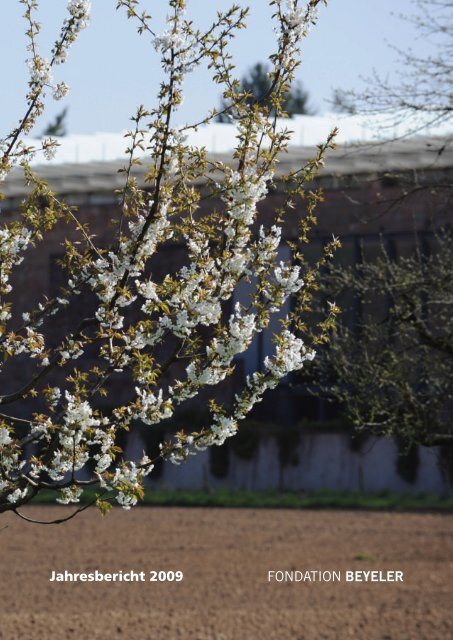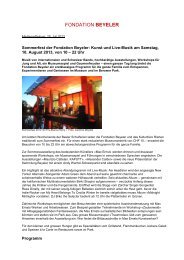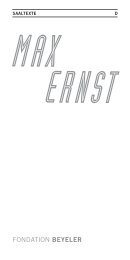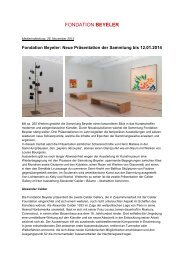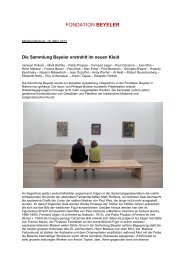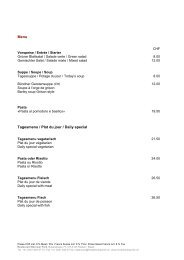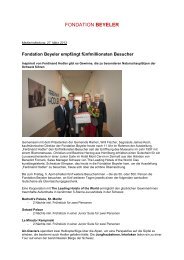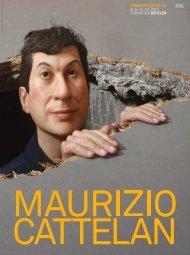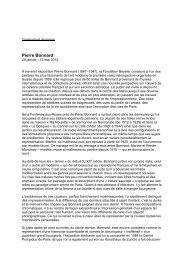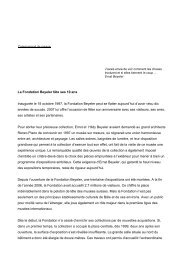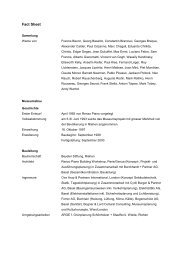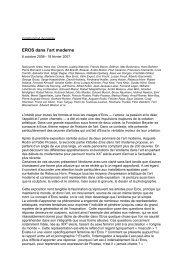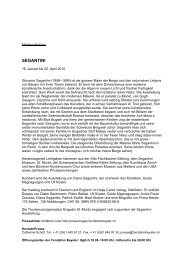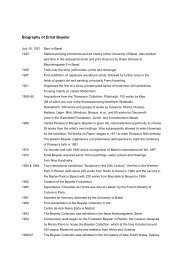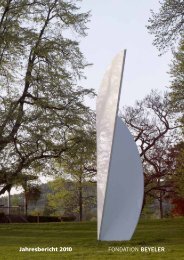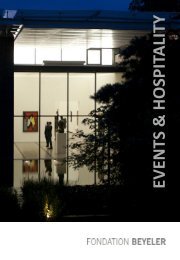Layout 4 - Fondation Beyeler
Layout 4 - Fondation Beyeler
Layout 4 - Fondation Beyeler
You also want an ePaper? Increase the reach of your titles
YUMPU automatically turns print PDFs into web optimized ePapers that Google loves.
Jahresbericht 2009<br />
FONDATION BEYELER<br />
1
Table of Contents<br />
Preface by the President of the Administration Board<br />
Memorial Speech by Eberhard W. Kornfeld<br />
at the Funeral of Ernst <strong>Beyeler</strong><br />
The Director’s Review of the Year<br />
The <strong>Fondation</strong> <strong>Beyeler</strong> as an International Cultural Institution<br />
The Year 2009 in Words<br />
The Year 2009 in Figures<br />
Notes on items in the Income Statement<br />
Administration Board and Business Management<br />
Colophon<br />
3<br />
4<br />
7<br />
12<br />
14<br />
16<br />
17<br />
19<br />
20<br />
1
Preface by the President of the Administration Board<br />
Ernst <strong>Beyeler</strong> died on February 25, 2010. For some time, his gradually failing<br />
health and stamina had prevented him from participating fully in the museum’s<br />
affairs. This was a painful experience for <strong>Beyeler</strong> and those around him, because<br />
it contrasted so strongly to the times when his presence was felt always and<br />
everywhere, creating the atmosphere that was so intimately connected with<br />
his personality.<br />
This is not the place to pay homage to Ernst <strong>Beyeler</strong> and his achievements.<br />
All we can do is emphasize once again how grateful we are for the opportunity<br />
to work for and with him. A great gap has been left by this inspiring and<br />
active man, yet we still cherish enriching memories of Ernst and Hildy <strong>Beyeler</strong><br />
and gladly accept the obligation to continue their work in their spirit.<br />
We can look back on the year 2009 with pleasure and satisfaction. It began<br />
under the cloud of gloomy economic prospects, and we were not sure how<br />
strongly the widespread insecurity would affect our visitor numbers. In retrospect,<br />
it would appear that the <strong>Fondation</strong> <strong>Beyeler</strong> with its rich exhibition<br />
schedule was perhaps just the place people needed to provide a respite from<br />
their day-to-day worries. Over 325,000 visitors found their way to our museum<br />
in Riehen in 2009. The <strong>Fondation</strong> <strong>Beyeler</strong> remains one of the leading cultural<br />
institutions in Switzerland and beyond.<br />
Our series of outstanding presentations was continued with three exhibitions:<br />
“Visual Encounters”, a reciprocal inspiration and dialogue between sculptures<br />
and masks from Africa, Oceania and Indonesia on the one hand, and classical<br />
modern art on the other. Then came “Giacometti”, focusing on Alberto’s art<br />
and supplemented by works by members of his family. Towards the end of<br />
the year, “Jenny Holzer” not only filled the museum spaces with her messages<br />
in light but fascinated the public with her large-scale outdoor projections.<br />
None of this would have been possible without the museum team, who,<br />
inspired and led by Sam Keller, performed superbly under pressure of time and<br />
success. We are extremely grateful to them all.<br />
Thanks are also due to the communities that support us, the two Basels<br />
and the Community of Riehen, to our sponsors, patrons, lenders and friends,<br />
and not least to all of those art lovers whose visits encourage us to maintain<br />
our traditional high level of quality.<br />
On behalf of the Board of Directors<br />
Dr. Georg Krayer<br />
3
Funeral Oration for Ernst <strong>Beyeler</strong>,<br />
by Eberhard W. Kornfeld, March 5, 2010<br />
We have come together today to bid farewell to Ernst <strong>Beyeler</strong>. We bow down<br />
before a life’s work whose effect spread far beyond Basel and Switzerland,<br />
and counts among the great achievements in the world of twentieth-century<br />
art. His was a fine and rich life, crowned with successes of a kind granted to<br />
few, and with accomplishments that will retain their significance far beyond<br />
his death.<br />
We met very early on in Basel; he was two years older. Our young years were<br />
marked by great austerity, the privations of war, and long military service,<br />
both of us in the Basel Regiment 22, confined to Switzerland, no contacts with<br />
the visual arts in Europe, no trips abroad. The beginnings of our professional<br />
activity ran almost in parallel. After graduating from high school, Ernst <strong>Beyeler</strong><br />
studied for a brief period, then became a trainee with a German emigré,<br />
Oskar Schloss, who after his flight from Germany had become a quite successful<br />
antiquarian bookseller in the space of only a few years. In my case, it was<br />
Bern with August Klipstein, he too of German origin but resident in Bern since<br />
1919. In the first year of our career, both of us earned the same wage, 100<br />
francs a month. Supplementary income was sorely needed. In our first financial<br />
transaction, we acquired an incomplete French Book of Hours and amicably<br />
divided the miniatures and manuscript pages with an eye to selling them<br />
to friends and small collectors. The miniatures were in fact quite good specimens<br />
of mid-fifteenth-century painting.<br />
Establishing a career basis was not easy for either of us. Both Oskar Schloss<br />
and August Klipstein died prematurely; both of us, barely over 25, had to<br />
assume the management of the firms and their development. From humble<br />
beginnings, <strong>Beyeler</strong>’s “Librairie du Château d’Art” (a bookshop named in allusion<br />
to Schloss), had by 1951 burgeoned into “Galerie <strong>Beyeler</strong>,” which enjoyed<br />
great international acclaim on account of annual, increasingly important<br />
exhibitions – each accompanied by one of his beautiful and elaborately designed<br />
catalogues. One great name followed another, yet not only established<br />
artists but the contemporary scene in Basel and Switzerland was taken into<br />
account, leading to many lasting friendships between Ernst <strong>Beyeler</strong> and Basel<br />
artists.<br />
Everything began at Bäumleingasse 9, where the antiquarian bookshop<br />
occupied one floor. <strong>Beyeler</strong> remained faithful to this venerable historical<br />
house, ultimately extending his operations to every floor and into every nook<br />
and cranny. This was the seed of many great activities and accomplishments.<br />
4
Over the long decades, he was an ardent observer of the international auction<br />
scene in Europe and New York, always with an eye to acquiring fine pieces<br />
for the gallery or his private collection, focusing on the period from Impressionism<br />
to Classical Modernism, and down to the present day. He was a welcome<br />
guest in London, Paris, New York, not to mention Bern and Zurich.<br />
A love of and devotion to nature was an early determinant in his life. In<br />
the forties and early fifties it was still mountaineering that provided compensation<br />
for the stresses of business. We often went out together. I recall our<br />
ascent of the Balmhorn in the Berner Oberland, accompanied by our brothers,<br />
both of whom were sadly destined to die at an early age. Further peaks would<br />
follow. Then there was the great devotion to rowing in Basel and environs<br />
from the forties onward, and in later years the weeks of recuperation in<br />
an out-of-the-way part of the island of Ios, one of the southernmost islands in<br />
the Cyclades, far from all social obligations. There, Ernst devoted himself to<br />
one of his quiet loves, watercolor painting.<br />
He was extremely committed to the environment. He never owned a private<br />
car in his life. His great concern for the rain forests is unforgettable; he<br />
assumed many responsibilities and established a highly successful foundation<br />
in order to contribute effectively to their protection.<br />
The early fifties saw Ernst <strong>Beyeler</strong>’s first considerable commercial successes.<br />
The books had vanished from the shelves and drawings and prints now hung<br />
on the walls; the first important paintings began to find their way into the<br />
gallery, gradually taking on the place of prominence in his activities. The auditing<br />
and a great part of the business operations lay in the competent hands of<br />
his unforgotten wife, Hildy. The increasingly high sales figures never became<br />
public; the problems that arose were solved within the family. It was this highly<br />
successful combination of art and commerce that formed the basis for the<br />
philanthropic activities that dominated Ernst <strong>Beyeler</strong>’s later years. Again and<br />
again, a major painting could be set aside and earmarked for his envisaged<br />
private collection, which would ultimately take on phenomenal dimensions.<br />
The first presentation of the entire private collection took place in 1989, in the<br />
recently inaugurated Centro de Arte Reina Sofia, within the walls of an old<br />
Madrid hospital converted into a museum, where Goya had already been<br />
inspired to works in his Disasters of War cycle. The quality and richness of the<br />
exhibition came as a great surprise to the art world, and whetted the appetite<br />
of many museums. In the end, however, the idea of his own institution in Riehen<br />
won out in <strong>Beyeler</strong>’s mind, after his entire holdings had passed to a foundation<br />
years before. The choice of Renzo Piano as architect was a stroke of<br />
5
luck; yet still, the well-nigh perfect museum building was strongly influenced<br />
by its patron and bears his personal touch.<br />
In October 1997, with the inauguration of the <strong>Fondation</strong> Ernst and Hildy<br />
<strong>Beyeler</strong>, came the culmination of his career. Ernst was 74 years old at the time,<br />
but still in full possession of his powers. For many years he managed the business<br />
operations himself. Magnificent and still legendary exhibitions drew the<br />
international acclaim still enjoyed by this unique institution. Likewise unforgettable<br />
is the installation Wrapped Trees created by Christo and Jean-Claude<br />
in the spacious <strong>Fondation</strong> park.<br />
Due to worsening health in the last two years of his life, Ernst <strong>Beyeler</strong> gradually<br />
passed on the management of gallery and foundation to talented staff<br />
members, who deserve profound gratitude for their devotion to his life’s work<br />
and its continuation. The future now lies in their hands.<br />
Four weeks ago, on the occasion of the opening of the “Henri Rousseau”<br />
exhibition, we still sat over lunch together in the exhibition, whose perhaps<br />
most beautiful picture, a Jungle Painting, is in <strong>Fondation</strong> <strong>Beyeler</strong>. Although<br />
marked by his declining health over the past two years, Ernst still took an<br />
active part in the event and obviously enjoyed this further high point in the<br />
foundation’s history. It was destined to be our last meeting.<br />
Now we must relinquish the mortal remains of this great man, yet his work<br />
and his name will continue to profoundly influence us and generations to<br />
come.<br />
Eberhard W. Kornfeld<br />
6
The Director’s Review of the Year<br />
The <strong>Fondation</strong> <strong>Beyeler</strong> was extremely successful in 2009, managing to reach<br />
its goals in both qualitative and quantitative respects. Fortunately we remained<br />
unaffected by accidents, damage and scandal. Fruitful co-operations were<br />
entered with various local and international cultural institutions, helping<br />
us to further cement our position among the leading art museums in the world.<br />
The year 2009 began with an admissions record. A total of 226,000 art lovers<br />
found their way to the exhibition “VENICE – From Canaletto to Turner and<br />
Monet,” which opened on September 28, 2008, and ran to February 15, 2009.<br />
Under the supervision of guest curator Martin Schwander, the exhibition<br />
devoted to the great city of art and its influence on the development of modern<br />
art comprised about 150 paintings, watercolors, pastels, and etchings from<br />
three centuries.<br />
“Visual Encounters – Africa, Oceania and Modern Art” focused for the first<br />
time on the extra-European art in the <strong>Beyeler</strong> Collection. The dialogue between<br />
cultures, wonderfully staged by curator Oliver Wick, comprised over 180 objects.<br />
The exhibition was organized in conjunction with the Museum der Kulturen,<br />
Basel, the Museum Rietberg, Zurich, and the Musée Barbier-Mueller, Geneva,<br />
and attracted 127,359 viewers.<br />
Our summer exhibition, “Giacometti”, was devoted to perhaps the most significant<br />
of all Swiss artists. Curated by Ulf Küster, it traced Giacometti’s development<br />
by reference to about 150 sculptures, paintings, and drawings, while<br />
shedding light on his relationships with family members. Thanks to a cooperation<br />
with the Giacometti foundations in Zurich and Paris, an impressive retrospective<br />
was mounted, which also paid respect to the outstanding merits of<br />
Ernst <strong>Beyeler</strong> as a supporter of Alberto Giacometti. A total of 152,894 visitors<br />
were counted.<br />
The last large exhibition of the year was devoted to the American artist Jenny<br />
Holzer. On view were LED installations, paintings, and sculptures. A total of<br />
47,682 visitors saw these pieces, in which personal and political statements<br />
combine with fascinating effects of color and light to engender poetic works<br />
of art.<br />
7
The tradition of art projects in the public space, initiated by Ernst <strong>Beyeler</strong>, found<br />
a continuation in Jenny Holzer’s large-scale projections on the <strong>Fondation</strong> <strong>Beyeler</strong><br />
museum building, Basel City Hall and Minster, SBB Station, Margarethen Hill,<br />
and on the Limmat and Lindenhof in Zurich, which were enjoyed by a wide<br />
audience. In collaboration with the mobile communications company Sunrise,<br />
the artist mounted her first virtual project, which enabled a million users to<br />
download Holzer’s works on their mobile phones free of charge. In addition, a<br />
cooperation with the Basel-Land culture bureau enabled a workshop for<br />
school classes with Jenny Holzer.<br />
The <strong>Fondation</strong> <strong>Beyeler</strong> held artistic responsibility for Il tempo del postino,<br />
an artists opera in which a range of leading contemporary artists participated.<br />
The project was organized in cooperation with Art Basel and Basel Theater,<br />
and supported by both Basel cantons.<br />
Interesting exhibitions of the work of contemporary artists were held on the<br />
lower floor of the <strong>Fondation</strong>. Franz West showed his “possessable” objects,<br />
Marc Quinn four self-portraits composed of his own frozen blood, and Günther<br />
Förg created an atmospherically compelling installation composed of<br />
photographs and murals.<br />
In 2009 the <strong>Fondation</strong> <strong>Beyeler</strong> had a stand at the most important European<br />
art fair, Art Basel, and its American counterpart, Art Basel Miami Beach,<br />
with an eye to disseminating its exhibition schedule and attending to lenders,<br />
museums and patrons. In addition, in my capacity as director I was invited to<br />
moderate conversations with artists James Rosenquist, Dan Graham, and<br />
Pierre de Meuron in Miami.<br />
The <strong>Fondation</strong> <strong>Beyeler</strong> organized a multifarious program of cultural events<br />
in 2009, which began with a collaboration with the Basel Theater and<br />
Opera on the occasion of the “Venice” exhibition. In connection with “Visual<br />
Encounters”, an international scholarly Nukuoro symposium, an African concert<br />
with Bassekou Kouyate from Mali, and an Oceanian film soiree at which<br />
philosopher Stefan Zweifel and film expert This Brunner introduced Friedrich<br />
Wilhelm Murnau’s South Seas melodrama Taboo were held. In addition, we<br />
hosted an artist’s talk with Yinka Shonibare and the former Documenta head<br />
Okwui Enwezor. Hans Ulrich Obrist moderated an artist’s talk with Franz West,<br />
followed by a musical performance by Philipp Quehenberger. A further conversation<br />
brought together architect Jacques Herzog and artist Jenny Holzer.<br />
In cooperation with the Kulturbüro Riehen, the renowned choreographer<br />
William Forsythe showed his Monster Partitur/Score in connection with the<br />
8
“Giacometti” exhibition. Together with ACT Entertainment a concert by The<br />
NITS took place, and we also contributed once again to the festival les muséiques.<br />
Our museum night at the <strong>Fondation</strong> attracted a crowd of over 7,000.<br />
The Rendez-vous series continued with prominent art lovers such as choreographer<br />
Richard Wherlock, jazz musician George Gruntz, author Ingrid Noll,<br />
acrobat David Dimitri, cabaret performer Viktor Giacobbo, the band Lovebugs,<br />
and carnival committee president Felix Rudolf von Rohr.<br />
In parallel with the “Giacometti” exhibition, readings were held by the author<br />
Tahar Ben Jelloun and actress Marie-Christine Barrault, and a cabaret evening<br />
with Massimo Rocchi took place.<br />
In collaboration with Ringier, an installment of “Arguments” was held for the<br />
first time in Basel, on the <strong>Fondation</strong> <strong>Beyeler</strong> premises. Moderated by editor-inchief<br />
Hannes Britschgi, the topic of the “Economic Miracle Basel” was discussed<br />
by Basel government councillor Christoph Brutschin, theater director Georges<br />
Delnon, Baloise president Rolf Schäuble, and Novartis president Daniel Vasella.<br />
The event was highly acclaimed by the approximately 200 invited representatives<br />
of business and commerce. The invitation of governments and parliaments of<br />
the two Basels, and the community council of Riehen, to attend a spring reception<br />
at the <strong>Fondation</strong> <strong>Beyeler</strong> has by now become a good tradition.<br />
An illustrious addition to the <strong>Beyeler</strong> Collection came in the shape of a tinuaitu<br />
figure from the Micronesian Nukuoro Atoll, a rare piece marked by its<br />
abstracted form. Moreover, the collection was presented in two, entirely unprecedented<br />
ways. Numerous loans to the “Visual Encounters – Africa, Oceania<br />
and Modern Art” exhibition, and Cube (1933-34) from the collection of the<br />
Alberto Giacometti Foundation, were obtained on extended basis. Further<br />
significant extended loans from private collections – including works by Picasso,<br />
Arp, Barnett Newman, and Jackson Pollock – were entrusted to the museum<br />
for a time. Last year, all insurance values for the loan of works in the collection<br />
were audited and brought up to date.<br />
Our restoration team investigated 55 works and conducted a further 22<br />
conservation measures, as well as supervising the presentations of the collection<br />
and exhibitions. Together with Nationale Suisse, we began an ambitious<br />
research project planned to last several years: Acanthes, devoted to the eponymous<br />
large-format paper cut-out work by Henri Matisse. Since the beginning<br />
of the year, the team’s efforts can be followed in a special museum studio or<br />
online by experts and the public alike.<br />
9
A total of 54 works from the <strong>Beyeler</strong> Collection were lent for major exhibitions<br />
at renowned museums around the world, including the Albertina in Vienna,<br />
the Hamburger Kunsthalle, the Centre Georges Pompidou and Musée d’Orsay<br />
in Paris, the National Gallery and Tate Modern in London, the Galleria Borghese<br />
in Rome, the Gemeentemuseum in The Hague, the Museo del Prado in Madrid,<br />
the Los Angeles County Museum, the Philadelphia Museum of Art, and the<br />
Metropolitan Museum and Guggenheim Museum in New York. The van Gogh<br />
show at the Kunstmuseum Basel was enhanced by two of the artist’s landscapes<br />
from the collection which, as a rule, are not available for loan.<br />
In accordance with the Foundation’s purpose, a number of programs designed<br />
to bring art to the public and especially to awaken young people’s interest<br />
in modern art were offered. The team of twenty-five guides conducted a total<br />
of 1,233 private and public guided tours, and organized 575 museum visits<br />
for school classes with workshops to follow. A total of 20,286 audio guides in<br />
German, French and English were issued to visitors.<br />
A scholarly catalogue in German and English (with a French translation<br />
of the essays) was published to accompany each large exhibition. In the series<br />
“Museums in Switzerland,” a book about the <strong>Fondation</strong> <strong>Beyeler</strong> in four<br />
languages was published in conjunction with the Swiss Institute for Art SIK<br />
and sponsored by the BNP Paribas Foundation. The magazines DU and<br />
Beaux Arts Magazine devoted special issues to the “Giacometti” exhibition.<br />
The <strong>Fondation</strong> <strong>Beyeler</strong> joined Hatje Cantz Verlag to publish an audio book to<br />
accompany this exhibition, becoming the first Swiss museum to do so. The<br />
labels and descriptions of works in the entire museum and park were revised<br />
or supplemented in several languages.<br />
Many artists and other personalities honored the <strong>Fondation</strong> with a visit in<br />
2009, including Federal Councillor Moritz Leuenberger, Christoph Blocher, Kofi<br />
and Nane Annan, Jacques Chirac, Georg and Elke Baselitz, Elke Heidenreich,<br />
Ed Ruscha, Francesco Clemente, Günther Förg, Franz West, Jenny Holzer, and<br />
Renzo Piano.<br />
A total of 3,132 journalists visited the <strong>Fondation</strong> <strong>Beyeler</strong> in 2009, and their<br />
over 3,000 articles in the print and electronic media marked a new record. This<br />
amounted to a considerable contribution on our museum’s part to the marketing<br />
of the Community of Riehen and the Basel Region as a prime location.<br />
10
We are grateful to the <strong>Beyeler</strong>- Foundation and Hansjörg Wyss Foundation<br />
for their generous support. We owe a debt of gratitude to the Canton of<br />
Basel-Stadt and Community of Riehen for their subsidies and to the Canton of<br />
Basel-Land for their contributions to our projects. The <strong>Fondation</strong> <strong>Beyeler</strong> thanks<br />
its sponsors, namely Basler Kantonalbank, <strong>Fondation</strong> BNP Paribas Suisse,<br />
Sarasin & Cie AG Bank, Bayer Consumer Care AG, Maybach, Nationale Suisse,<br />
Hatje Cantz Verlag, UBS AG, Kuhn & Bülow, Novartis, Helvetia and ISS Facility<br />
Services AG for their cooperative partnership in the year 2009. We are grateful<br />
to Sibylla M. and Christoph M. Müller for the valuable support they provided<br />
for our youth work, and the Coromandel Foundation for its commitment.<br />
Heartfelt thanks to our supporters group, the Friends of the <strong>Fondation</strong> <strong>Beyeler</strong>,<br />
our corporate members, and the members of the Art Club, who annually<br />
provide significant moral and financial support. Finally, our thanks go to our<br />
entire staff, who commit themselves with passion and a sense of quality to<br />
putting the Foundation’s goals into practice.<br />
Sam Keller<br />
Director, <strong>Fondation</strong> <strong>Beyeler</strong><br />
11
The <strong>Fondation</strong> <strong>Beyeler</strong> as an International Cultural Institution<br />
The <strong>Fondation</strong> <strong>Beyeler</strong> is not only an internationally recognized collection and<br />
active as an exhibition venue in Riehen. Its presence as a cultural institution<br />
has long begun to extend far beyond the borders of Basel and Switzerland.<br />
This development has been especially facilitated by loans from the Ernst and<br />
Hildy <strong>Beyeler</strong> Collection to other museums’ exhibition projects. In our view,<br />
a loan request is always an indication of the significance of our collection,<br />
whose many key works can form high points in the presentations of other<br />
institutions. Of course, each loan request raises the question of whether the<br />
work concerned is capable of traveling at all. Once this is settled, we can turn<br />
to the themes of the planned exhibitions and the institutions involved, the<br />
great majority of which are themselves lenders to our own exhibition projects.<br />
Over the years, the exchange of loans among museums has given rise to a<br />
sort of international diplomatic network, in which the <strong>Fondation</strong> <strong>Beyeler</strong> plays<br />
a significant role. The exchange involves many museum departments, the<br />
curators, restorers, registrars, and art handling. The presence of the <strong>Fondation</strong><br />
<strong>Beyeler</strong> at the world’s two most important art fairs, Art Basel and Art Basel<br />
Miami Beach, contributes to the museum’s international reputation as an outstanding<br />
cultural institution.<br />
Yet the <strong>Fondation</strong> <strong>Beyeler</strong> is active outside its “own four walls” not only as<br />
regards loan exchanges. We are becoming increasingly involved in the organization<br />
of cultural events outside Riehen. During Art 40 Basel in 2009, the artists<br />
opera Il tempo del postino, staged by Hans-Ulrich Obrist, Rirkit Tiravanija<br />
and Philippe Parreno with the participation of a group of prominent contemporary<br />
artists, had its highly successful premiere at the Basel Theater. In collaboration<br />
with the theater and Art Basel, the <strong>Fondation</strong> <strong>Beyeler</strong> functioned<br />
as co-producer of the event.<br />
Of increasing significance for the <strong>Fondation</strong> <strong>Beyeler</strong> – in both artistic and<br />
financial respects – are co-productions of exhibition projects and the passing on of its<br />
own exhibitions to others. As a rule, each <strong>Fondation</strong> <strong>Beyeler</strong> show draws<br />
inquiries from a number of museums who would like to take it over. Though<br />
this is often not possible due to complicated loan situations, it does succeed<br />
quite frequently. Our highly successful “Venice” exhibition, for instance,<br />
will be on view in modified form at the renowned Musée Jacquemart-André in<br />
Paris from October 2010 to February 2011. The “Rousseau” exhibition will be<br />
shown at the Museo Guggenheim in Bilbao, and our “Basquiat” retrospective<br />
will travel to the Musée d’art moderne de la Ville de Paris.<br />
12
The “Jenny Holzer” exhibition was a joint production with the Museum of<br />
Contemporary Art in Chicago. Its further venues include the BALTIC Centre for<br />
Contemporary Art in Gateshead, from March 5 to May 16, 2010, after already<br />
having appeared at the Whitney Museum of American Art in New York. The<br />
exhibition will likely travel to Montreal, Canada, at a later date. On invitation<br />
from the Musée d’Orsay, in 2010 the <strong>Fondation</strong> <strong>Beyeler</strong> will additionally curate<br />
the exhibition “Paul Klee – La collection d’Ernst <strong>Beyeler</strong>” at the Musée de<br />
l’Orangerie in Paris. The <strong>Fondation</strong> <strong>Beyeler</strong>’s international activities make<br />
a considerable contribution to its international networking and renown as a<br />
leading museum of modern art.<br />
Dr. Ulf Küster<br />
Curator<br />
13
The Year 2009 in Words<br />
The year 2009 was an extremely successful year in every respect for the <strong>Beyeler</strong><br />
Museum AG. It brought a total of 325,759 art lovers to the <strong>Fondation</strong> <strong>Beyeler</strong><br />
and its exhibitions. As this indicates, the museum continues to be one of the<br />
most popular art institutions in Switzerland. From the financial point of view,<br />
we are proud to say that the annual results before loss coverage showed a<br />
considerable improvement by comparison to the previous year. The increase in<br />
all profit areas, with the exception of the contractually guaranteed subsidies,<br />
totalled approx. 17.4 million Swiss francs, nine percent higher than 2008.<br />
One contributing factor was an approx. nine percent growth in visitor numbers.<br />
The Art Shop reported a turnover of 3.8 million Swiss francs, comprised of<br />
46 percent art books and 26 percent art postcards, posters, editions and DVDs.<br />
The museum Restaurant Berower Park was also popular with the public and<br />
increased its turnover by 15 percent.<br />
In addition, we were able to increase sponsoring income – despite the loss of<br />
one sponsor but thanks to two new ones. The yield from “Art Club and Friends”<br />
showed an increase as well. Especially worth mention, finally, is the generous<br />
support for various exhibition projects provided by a range of foundations and<br />
private persons, which led to a full doubling of the amount of donations.<br />
We were fortunately able to reduce operating expenses by about 1.4 million<br />
Swiss francs, amounting to a decrease of about seven percent. Savings were<br />
made especially in the areas of art transport, insurance (for the “Jenny Holzer”<br />
exhibition, no insurance costs arose), public relations and advertising, but also<br />
in the area of energy consumption. The general exhibition expenses rose in<br />
2009, due to higher architectural costs for the presentation of sculptures and<br />
LED installations.<br />
In sum, the <strong>Beyeler</strong> Museum AG succeeded in slightly exceeding the budgeted<br />
overall results. About two-thirds of operating expenses were covered by operating<br />
yield, and a further one-sixth by subsidies and donations. The remaining<br />
3.5 million Swiss francs were borne, as per budget, by the <strong>Beyeler</strong>-Stiftung<br />
and Hansjörg Wyss Foundation.<br />
At this juncture we wish to thank everyone who contributed to the success of<br />
the business and exhibition year 2009, especially our staff. Our heartfelt<br />
thanks to the Administration Council, the councils of the <strong>Beyeler</strong>-Stiftung,<br />
14
our colleagues at Galerie <strong>Beyeler</strong>, and of course to all lenders and colleagues<br />
in other museums who contributed to making our exhibitions successful<br />
and internationally attractive. We greatly appreciate the generous support<br />
shown by our partners, subsidy providers, patrons, supporters, members and<br />
business friends. Finally, we wish to thank our visitors for the great interest<br />
they showed in our activities, and representatives of the press and media for<br />
their competent and exhaustive coverage.<br />
Many people contribute to taking the legacy of our founders, Hildy and<br />
Ernst <strong>Beyeler</strong>, securely into the future, and we are working to ensure the<br />
continuation of the <strong>Fondation</strong> <strong>Beyeler</strong> and its success.<br />
James Koch<br />
Deputy Director<br />
15
The Year 2009 in Figures<br />
Overview income statement 2009<br />
Figures in TCHF<br />
Income from visitors<br />
Income from sponsoring<br />
Income from Art Club and Friends<br />
Other museum income<br />
Operating income<br />
Cost of materials<br />
Personnel expenses<br />
Art transports and lending fees<br />
Art insurance<br />
General exhibition expenses<br />
Public relations and advertising<br />
Art education and events<br />
Buildings, security and energy<br />
Security personnel and facility management<br />
Other operating and administrative expenses<br />
Expanses for<br />
museum operation and exhibitions<br />
Operating expenses<br />
Operating income<br />
Subsidy from Community of Riehen<br />
Subsidy from Canton Basel-Stadt<br />
Contributions<br />
Subsidies and contributions<br />
Result before financial<br />
income and depreciation<br />
Financial income and depreciation<br />
Annual result before covering loss<br />
16<br />
Current Year<br />
2009<br />
11'312<br />
1'626<br />
502<br />
305<br />
13'744<br />
2'508<br />
5'586<br />
1'634<br />
1'156<br />
1'744<br />
1'825<br />
765<br />
2'056<br />
1'891<br />
1'593<br />
12'665<br />
20'759<br />
–7'015<br />
915<br />
1'865<br />
872<br />
3'652<br />
–3'363<br />
183<br />
–3'546<br />
Previous Year<br />
2008<br />
10'606<br />
1'563<br />
458<br />
168<br />
12'796<br />
2'801<br />
5'305<br />
3'039<br />
1'808<br />
1'068<br />
2'047<br />
747<br />
2'112<br />
1'839<br />
1'428<br />
14'089<br />
22'195<br />
–9'401<br />
906<br />
1'865<br />
428<br />
3'199<br />
–6'201<br />
139<br />
–6'339<br />
Difference<br />
2009/2008<br />
+705<br />
+63<br />
+44<br />
+136<br />
+949<br />
–293<br />
+281<br />
–1'405<br />
–652<br />
+675<br />
–222<br />
+18<br />
–55<br />
+52<br />
+165<br />
–1'424<br />
–1'436<br />
+2'385<br />
+9<br />
+0<br />
+443<br />
+452<br />
+2'837<br />
+45<br />
+2'793
Remarks on Individual Items in the Successful Balance 2008 / 2009<br />
Admissions yield<br />
The increase in admissions yield stands in direct relation to increased visitor<br />
numbers.<br />
Yield from sponsoring / yield from “Art Club and Friends”<br />
We enjoyed a slight increase in yields from sponsoring and membership fees<br />
despite the financial crisis year.<br />
Other museum yields<br />
Other museum yields increased due, among other things, to yields from<br />
museum services<br />
Materials expenses<br />
The difference from the previous year was due especially to better restaurant<br />
figures.<br />
Personnel expenses<br />
Personnel expenses of the <strong>Fondation</strong> <strong>Beyeler</strong> are relatively stabile; the increase<br />
for the report year was due especially to increased turnover in the restaurant<br />
and the concomitant additional (variable) employment of staff.<br />
Art transports and lending fees, art insurance, and general exhibition costs<br />
Each <strong>Fondation</strong> <strong>Beyeler</strong> exhibition is unique not only from an artistic point of<br />
view but with respect to cost structure. In the report year, relatively low transport<br />
and insurance costs arose in connection with “Visual Worlds” (African<br />
and Oceanian works of art), “Giacometti” (fragile sculptures, mainly from<br />
the collections of a few principal lenders from France and Switzerland), and<br />
“Jenny Holzer” (LED installations and projections in the public space). By<br />
contrast, expenses for exhibition architecture were higher by comparison to<br />
the previous years.<br />
Public relations and advertising<br />
Here, savings were seen in various areas by comparison to the previous year.<br />
17
Art appreciation and events<br />
The figures in these fields remained basically unchanged.<br />
Buildings, security and energy<br />
Especially notable in this area were slight decreases in energy consumption<br />
costs by comparison to 2008.<br />
Museum supervision and building management<br />
These costs were relatively stable. The disposition of supervisory personnel<br />
had to be adapted to visitor numbers and security situation for each<br />
exhibition.<br />
Other operational and administration costs<br />
These were higher than in the previous year especially in the restaurant,<br />
due to postponed maintenance needs.<br />
Donations<br />
A doubling of donations enabled the museum to make fascinating art<br />
projects a reality.<br />
18
Administration Council and Business Management<br />
The shares of <strong>Beyeler</strong> Museum AG are held to 100 percent by<br />
the <strong>Beyeler</strong> Foundation.<br />
The Administration Council of <strong>Beyeler</strong> Museum AG is composed of<br />
Dr. Georg Krayer, President<br />
Christoph Megert, Member<br />
Dr. Christoph Stutz, Member<br />
The business management of <strong>Beyeler</strong> Museum AG is composed of<br />
Samuel Keller, Director<br />
James Koch, Deputy Director<br />
The auditors of <strong>Beyeler</strong> Museum AG are PriceWaterhouseCooper AG, Basel.<br />
19
Illustrations in sequence of appearance<br />
1. Cover: West facade of the <strong>Fondation</strong> <strong>Beyeler</strong>, Peter Schnetz<br />
2. Water lily pond in front of the south facade of the <strong>Fondation</strong> <strong>Beyeler</strong>, Ben Ludwig<br />
3. Ellsworth Kelly’s White Curves in the morning, <strong>Fondation</strong> <strong>Beyeler</strong> park, Ben Ludwig<br />
4. View of the <strong>Fondation</strong> <strong>Beyeler</strong> park, Michael Babics<br />
5. Pavilion in the <strong>Fondation</strong> <strong>Beyeler</strong> park, Ben Ludwig<br />
6. View of Alexander Calder’s The Tree, 1966, and Ellsworth Kelly’s White Curves, 2001, Michael Babics<br />
7. South facade of the <strong>Fondation</strong> <strong>Beyeler</strong> with cherry trees, Ben Ludwig<br />
Colophon<br />
Publisher: <strong>Beyeler</strong> Museum AG<br />
Project head: Pia Kuchenmüller<br />
Team: Claudia Carrara, Dorothea Merz,<br />
Tanja Narr, Katrin Steiner<br />
Authors: Dr. Georg Krayer, Eberhard W. Kornfeld,<br />
Sam Keller,James Koch, Dr. Ulf Küster<br />
Design/layout: Heinz Hiltbrunner<br />
Photos: Peter Schnetz, Ben Ludwig, Michael Babics<br />
Copy editing: Holger Steinemann<br />
Translation: John William Gabriel<br />
E-Book layout: das formt, Büro für Kommunikation & Design<br />
Printing: Merkel Druck AG, Riehen<br />
Edition: 200 copies<br />
Many thanks to all concerned.<br />
FONDATION BEYELER<br />
<strong>Beyeler</strong> Museum AG,<br />
Baselstrasse 77, CH-4125 Riehen, Switzerland<br />
www.fondationbeyeler.ch<br />
20


